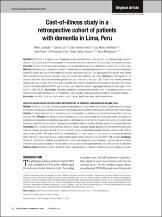Cost-of-illness study in a retrospective cohort of patients with dementia in Lima, Peru

View/
Download
(application/pdf: 650.3Kb)
(application/pdf: 650.3Kb)
Date
2015Author(s)
Custodio, Nilton
Lira, David
Herrera-Perez, Eder
Nuñez del Prado, Liza
Parodi, José
Guevara-Silva, Erik
Castro-Suarez, Sheila
Montesinos, Rosa
Metadata
Show full item recordAbstract
Dementia is a major cause of dependency and disability among older persons, and imposes huge economic burdens. Only a few cost-of-illness studies for dementia have been carried out in middle and low-income countries.
OBJECTIVE: The aim of this study was to analyze costs of dementia in demented patients of a private clinic in Lima, Peru. Methods. We performed a retrospective, cohort, 3-month study by extracting information from medical records of demented patients to assess the use of both healthcare and non-healthcare resources. The total costs of the disease were broken down into direct (medical and social care costs) and indirect costs (informal care costs). Results. In 136 outpatients, we observed that while half of non-demented patients had total care costs of less than US$ 23 over three months, demented patients had costs of US$ 1500 or over (and more than US$ 1860 for frontotemporal dementia). In our study, the monthly cost of a demented patient (US$ 570) was 2.5 times higher than the minimum wage (legal minimum monthly wage in Peru for 2011: US$ 222.22). Conclusion. Dementia constitutes a socioeconomic problem even in developing countries, since patients involve high healthcare and non-healthcare costs, with the costs being especially high for the patient's family.
Collections
- Artículos [274]







